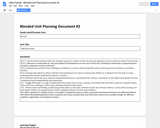
This unit walks students through a variety of activities revolving around George Orwell's book '1984'.
- Subject:
- English Language Arts
- Material Type:
- Unit of Study
- Provider:
- Michigan Virtual
- Author:
- Abby Perdok
- Date Added:
- 06/28/2017

This unit walks students through a variety of activities revolving around George Orwell's book '1984'.
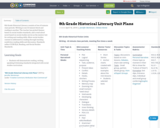
8th Grade Historical Literacy consists of two 43 minute class periods. Writing is one 43 minute block and reading is another. The teacher has picked themes based on social studies standards, and a read-aloud novel based on social studies serves as the mentor text for writing and reading skills. More social studies content is addressed in reading through teaching nonfiction reading skills and discussion.
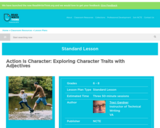
Students must "become" a character in a novel in order to describe themselves and other characters using powerful adjectives.
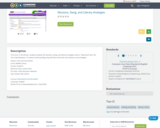
In this lesson, students analyze the allusions, slang, and literary analogies used in "Raymond's Run" by Toni Cade Bambara. To extend understanding, they will then write their own allusions and analogies.
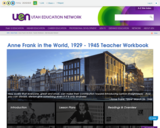
Overview: This Anne Frank unit is designed with several lessons of various lengths. These lessons are usable in many different disciplines. Using one, several, or all of the lessons will address the unit's objectives to some degree. Students will accomplish some or all of the objectives depending on the number and nature of the lessons in which they participate.
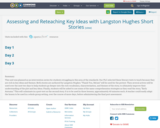
This unit was planned as an intervention series for students struggling in this area of the standards. Our PLC selected these literary texts to teach because they are rich in key ideas and themes. Both stories are authored by Langston Hughes. "Thank You, Ma'am" will be used for the pretest. Then several actives will be used over the next two days to help students go deeper into the rich vocabulary, characterization, and themes of the story, to ultimately improve their understanding of the plot and key ideas. Finally, students will be asked to use some of the same comprehension strategies as they read the story, "Early Autumn." This will culminate in a post-test on the second story. It is to be used in three lessons, approximately 40 minutes each. A teacher could easily adapt the lesson to be used in a whole group setting, over the course of more days, before administering the final post assessment.
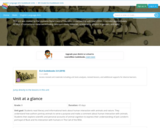
Students read literary and informational texts about human interaction with animals and nature. They understand how authors portray animals to serve a purpose and make a comment about human interaction with animals. Students then explore scientific and personal accounts of animal cognition to express their understanding of Jack London’s portrayal of Buck and his interaction with humans in The Call of the Wild.

Two blobs of clay go on an enjoyable adventure as they transform themselves into fun shapes and new things throughout their escapade. What will they be by the end of the book? The resource includes a lesson plan/book card, a design challenge, and copy of a design thinking journal that provide guidance on using the book to inspire students' curiosity for design thinking. Maker Challenge: Design a stop-motion video that morphs an item of your choice into another item. Before you begin, sketch out the process you’ll take to transform your item.
A document is included in the resources folder that lists the complete standards-alignment for this book activity.

Emily Dickinson's poetry often reveals a child-like fascination with the natural world. She writes perceptively of butterflies, birds, and bats and uses lucid metaphors to describe the sky and the sea.
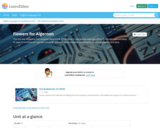
Students read literary and informational texts about knowledge and intelligence to understand what happens when humans try to manipulate the minds of others and how our understanding of intelligence has evolved over time. Students express their understanding of these ideas by exploring how authors draw on traditional stories and develop characters and themes to teach us about ourselves and others.
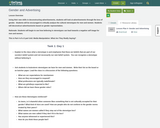
Using their new skills in deconstructing advertisements, students will look at advertisements through the lens of gender. Students will be encouraged to critically analyze the cultural stereotypes for men and women. Students will deconstruct advertisements based on gender representation.Rationale: Students will begin to see how believing in stereotypes can lead towards a negative self image for men and women. This is Part 4 of a 5 part Unit: Media Manipulation: What Are They Really Saying?

Students will read through chapter 12 of The Giver where they find that the people in The Giver got rid of the ability to see color. First students will look at a variety of colors and determine what emotions the colors make them feel. Then they will each write about a color without giving the name of the color; the students in the class will need to guess the color. After that assignment, students will analyze how colors affect behaviors and emotions and critically determine why the people in the that world decided to make everyone see in black and white. Students will end the lesson answering the question "Why do you think we have color in our world?"

The object consists of a text in the public domain that has been downloaded from the web, uploaded into the web-based application Kami, and annotated by me with instructions and reflection questions for the students. Students whould read the story while adding their own annotations (such as observations or questions). They may also highlight or underline sections of text and respond to the comments of other students.
The activity is meant to integrate a whole-class read-aloud and an independent active reading of the text, taking the best from both: students will be able to engage in a discussion with their classmates while reading reflecting, and annotating at their own pace.
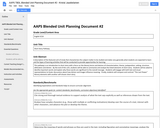
This pathway is an introduction to short story with a focus on the literary terms and devices of characterization, theme, juxtaposition, setting, structure, alliteration and diction. By the end of this unit, students will be able to summarize and analyze the listed elements of short story. Students will be asked to identify important words and explain why these words are significant to the overall message. Students will engage with both text and visual representations to foster discussions about how diction and images influence meaning. Finally, students will compare and contrast "The Last Flower" literary elements with another self-chosen short story.

The lessons in this unit provide you with an opportunity to use online resources to further enliven your students' encounter with Greek mythology, to deepen their understanding of what myths meant to the ancient Greeks, and to help them appreciate the meanings that Greek myths have for us today. In the lessons below, students will learn about Greek conceptions of the hero, the function of myths as explanatory accounts, the presence of mythological terms in contemporary culture, and the ways in which mythology has inspired later artists and poets.
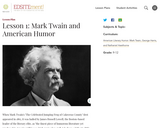
Uncover the sources of Twain's comic genius in American traditions of dialect humor and literary satire.
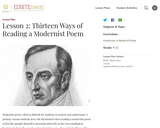
This lesson prompts students to think about a poem's speaker within the larger context of modernist poetry. First, students will review the role of the speaker in two poems of the Romanticism period before focusing on the differences in Wallace Stevens' modernist"Thirteen Ways of Looking at a Blackbird.
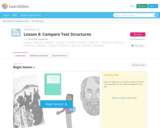
Students evaluate the advantages and disadvantages of different mediums and then compare and contrast the structure of the texts they have viewed/read to consider how the texts use different structures to convey similar ideas.
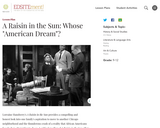
Lorraine Hansberry's A Raisin in the Sun provides a compelling and honest look into one family's aspirations to move to another Chicago neighborhood and the thunderous crash of a reality that raises questions about for whom the "American Dream" is accessible.
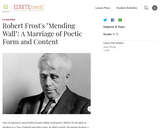
Studying Robert Frost's "Mending Wall," students explore the intricate relationship between a poem's form and its content.